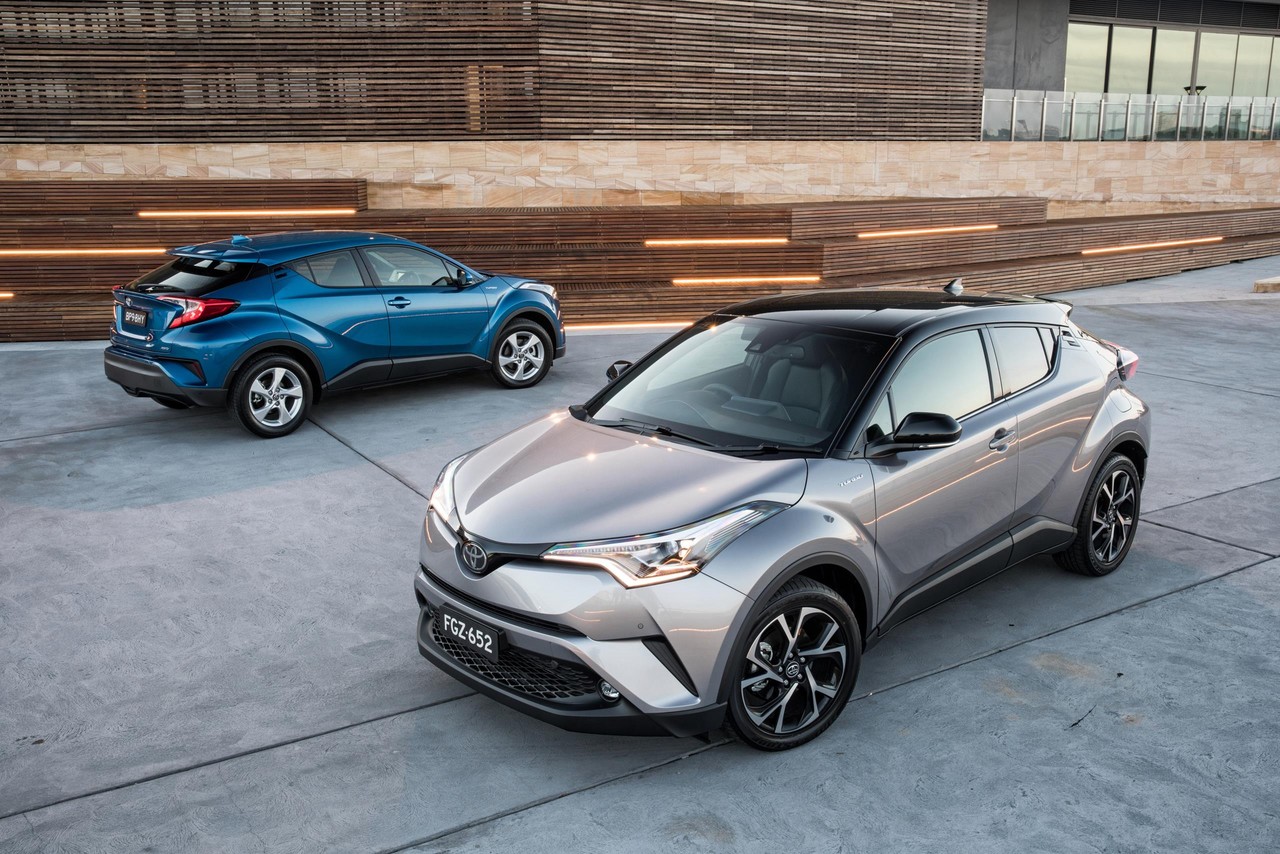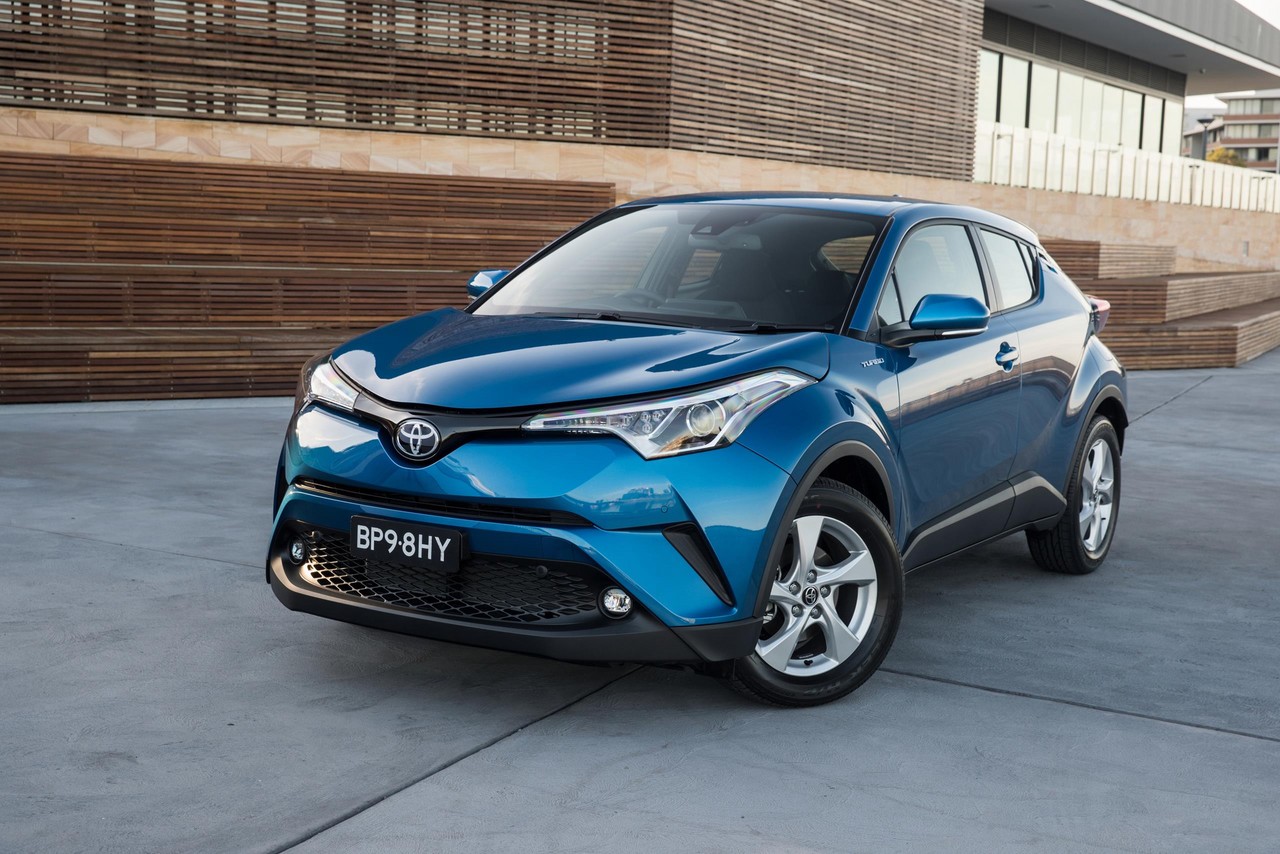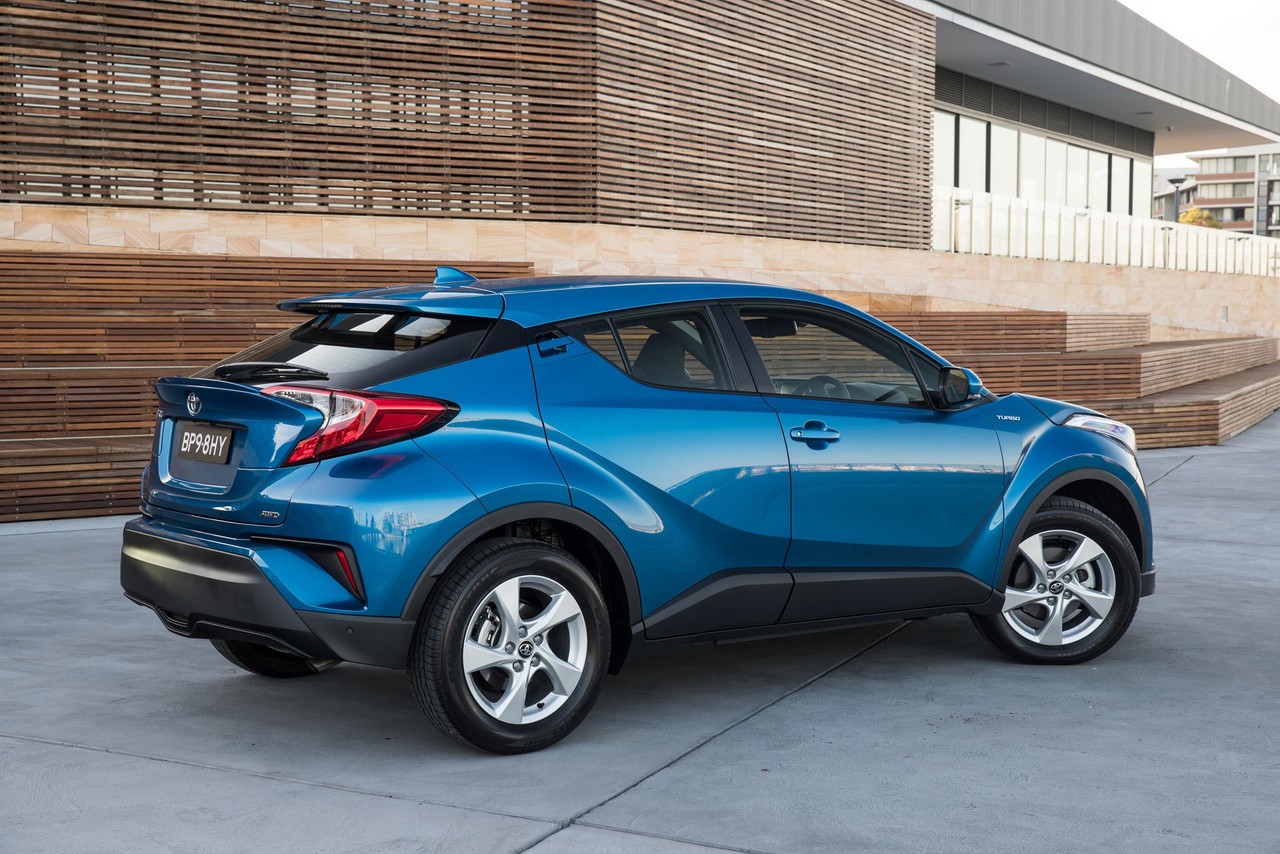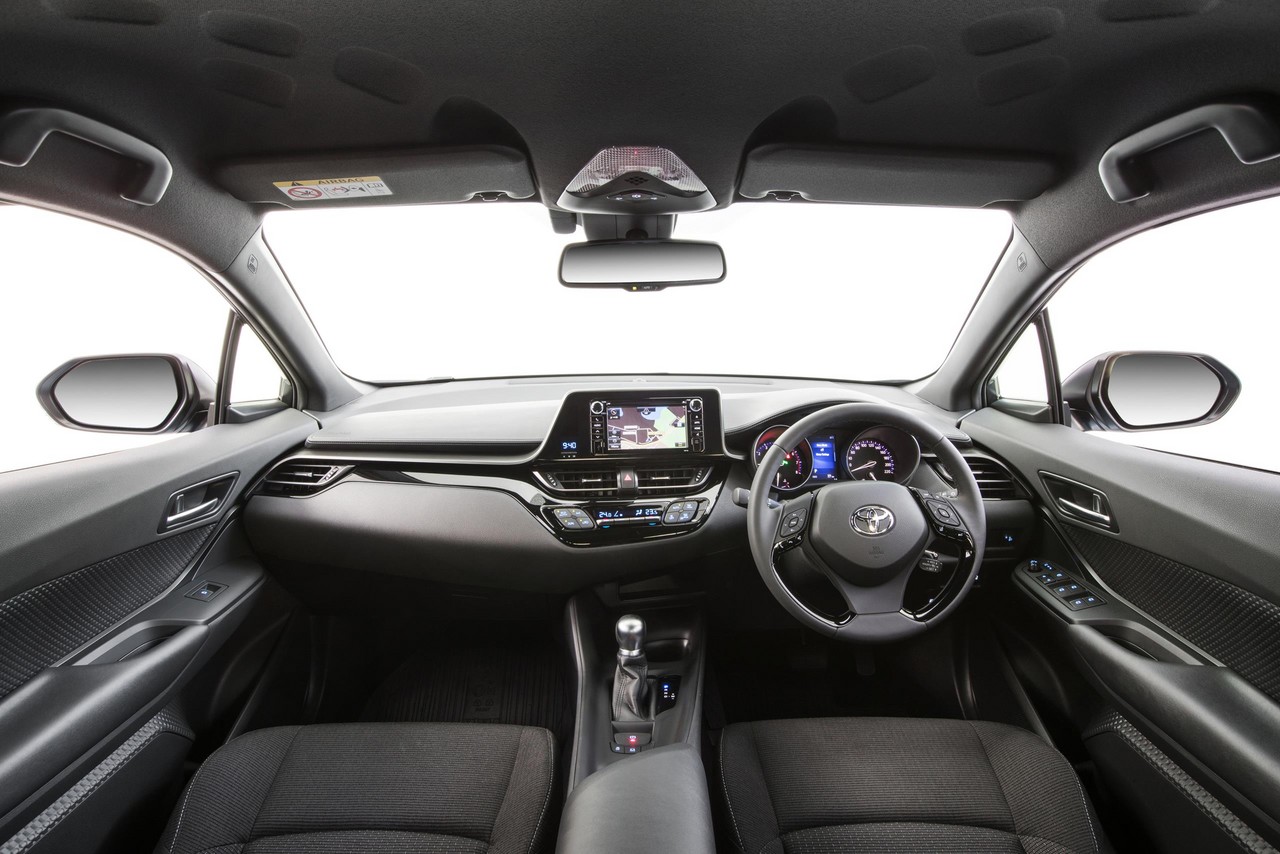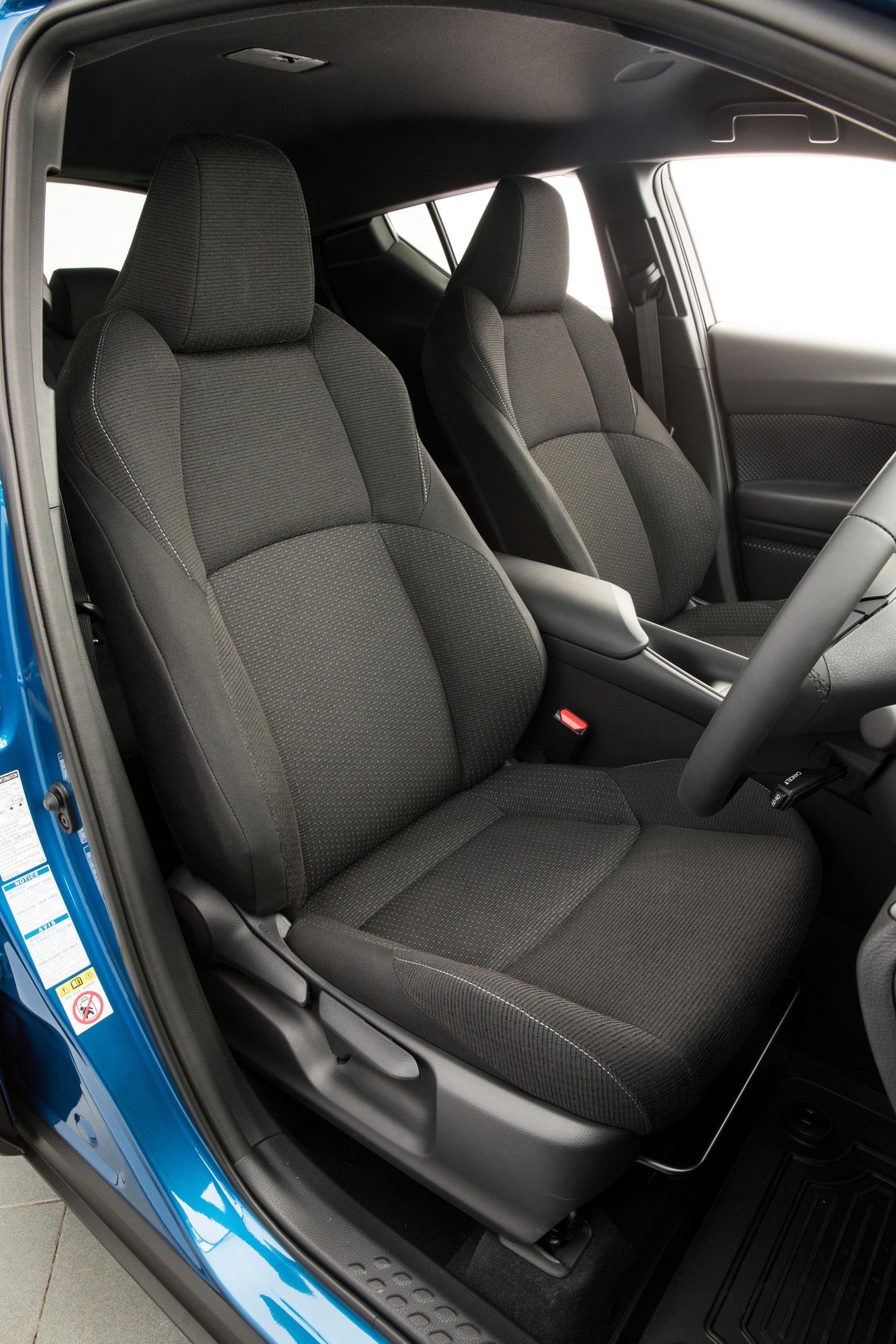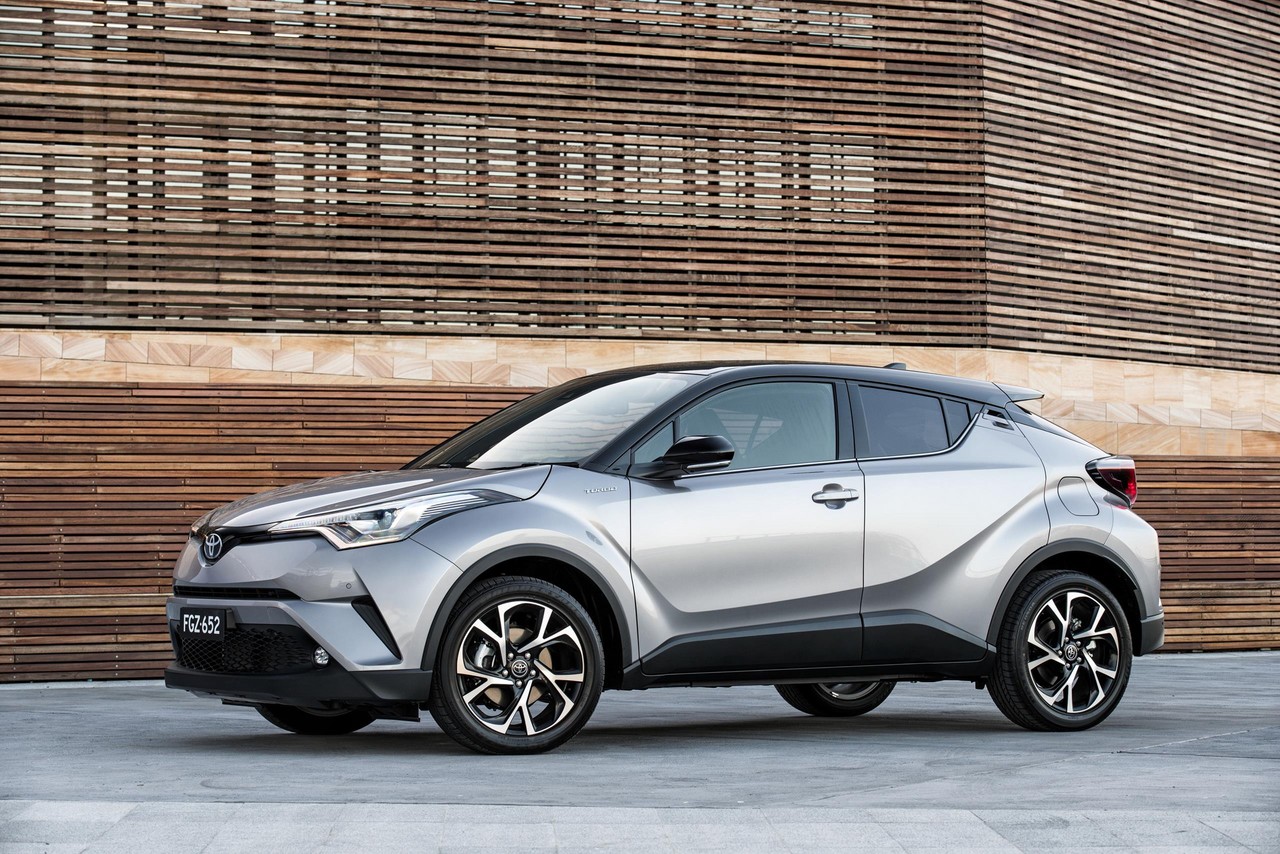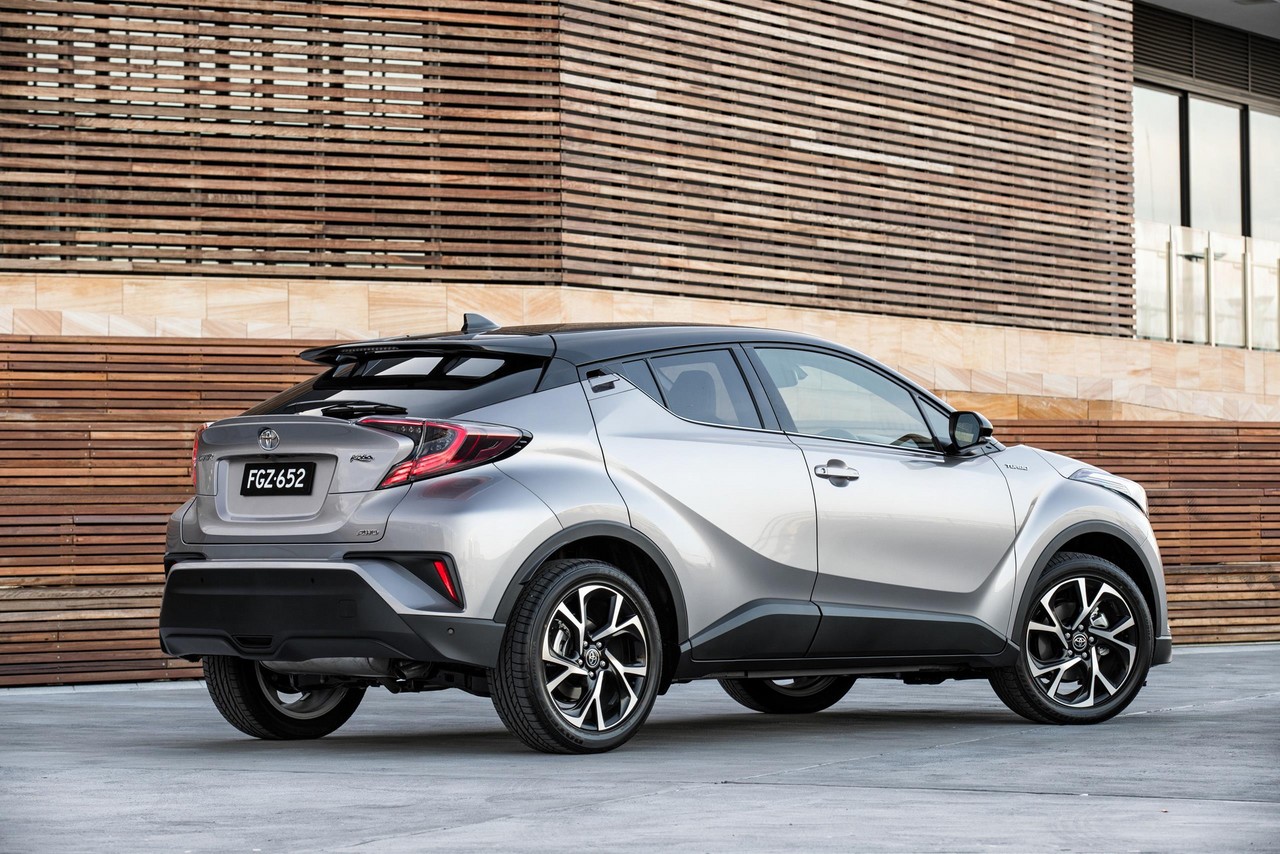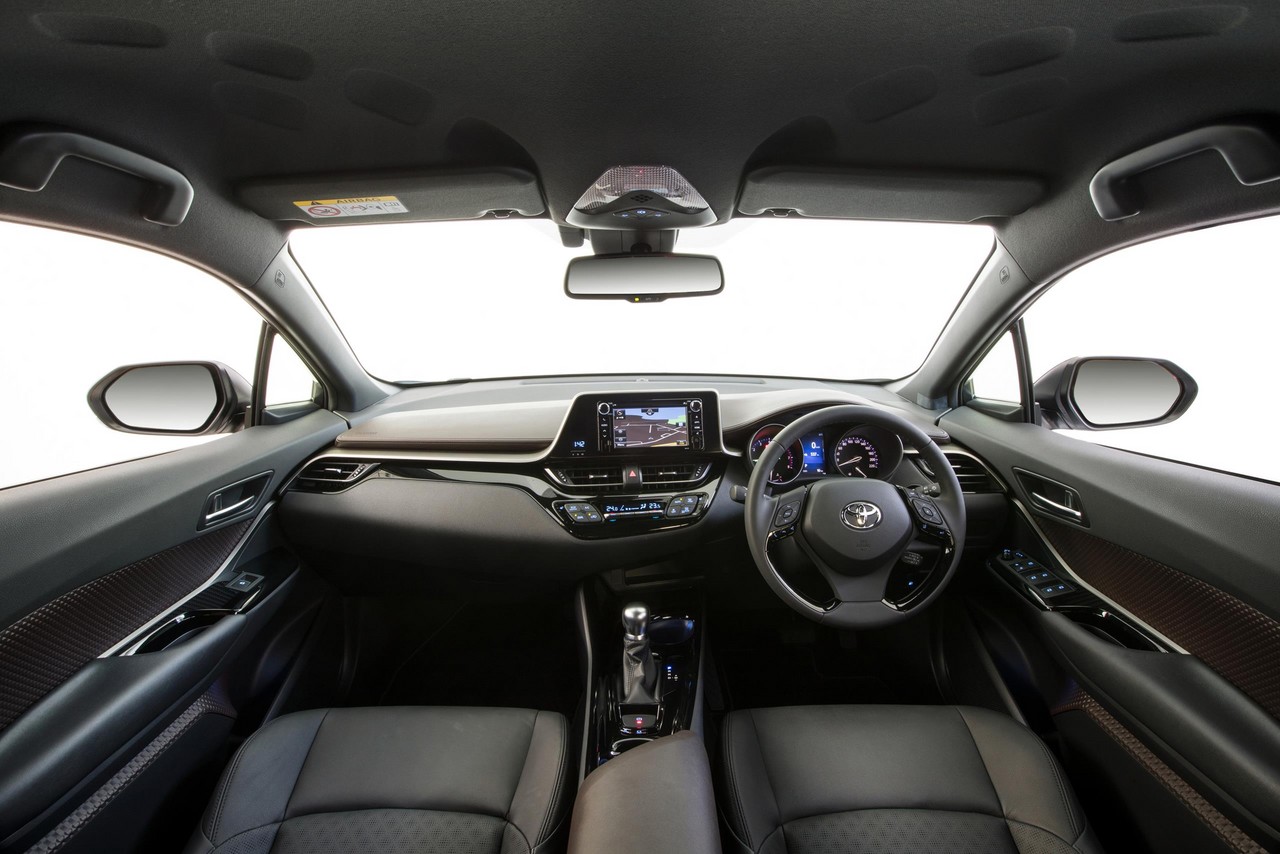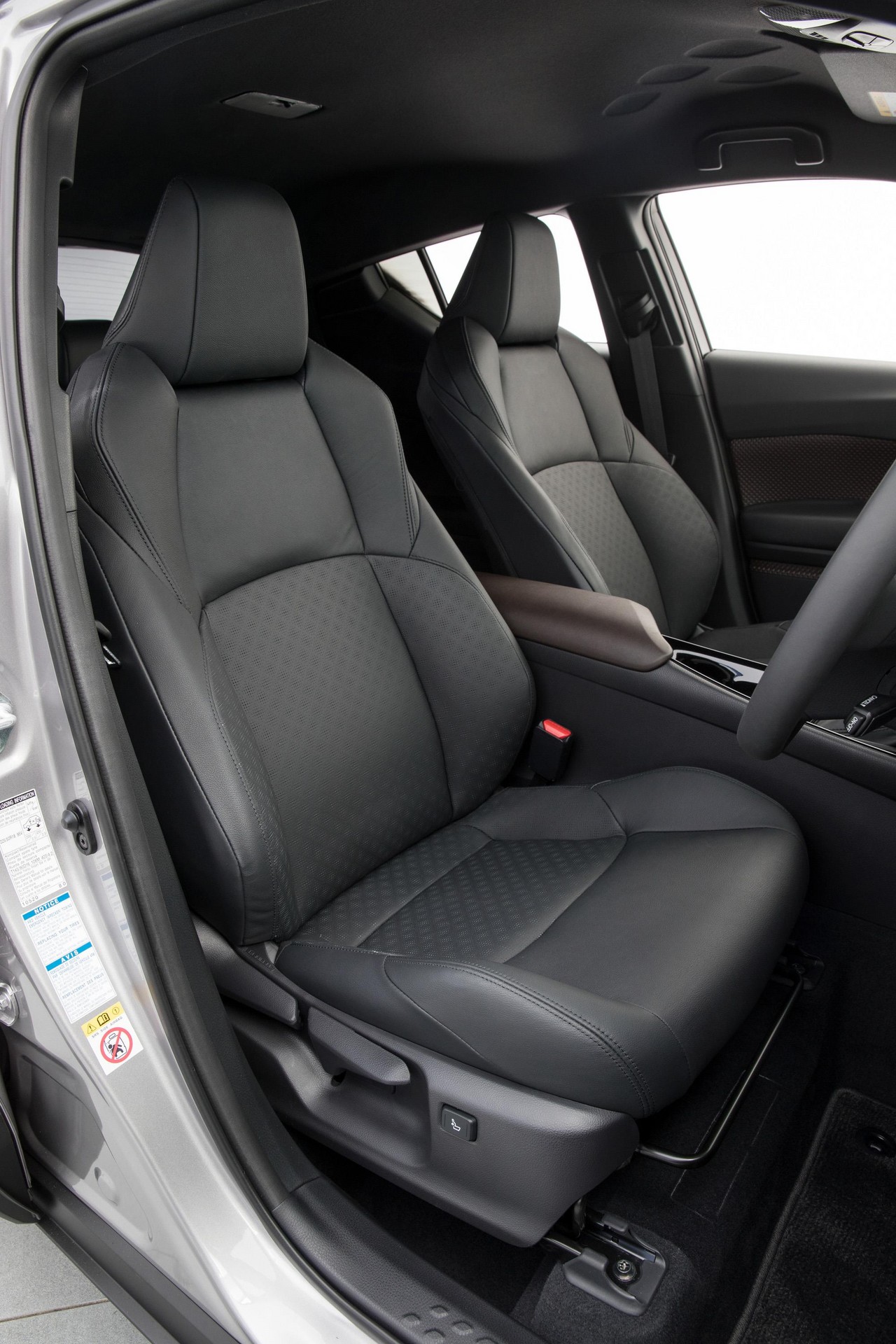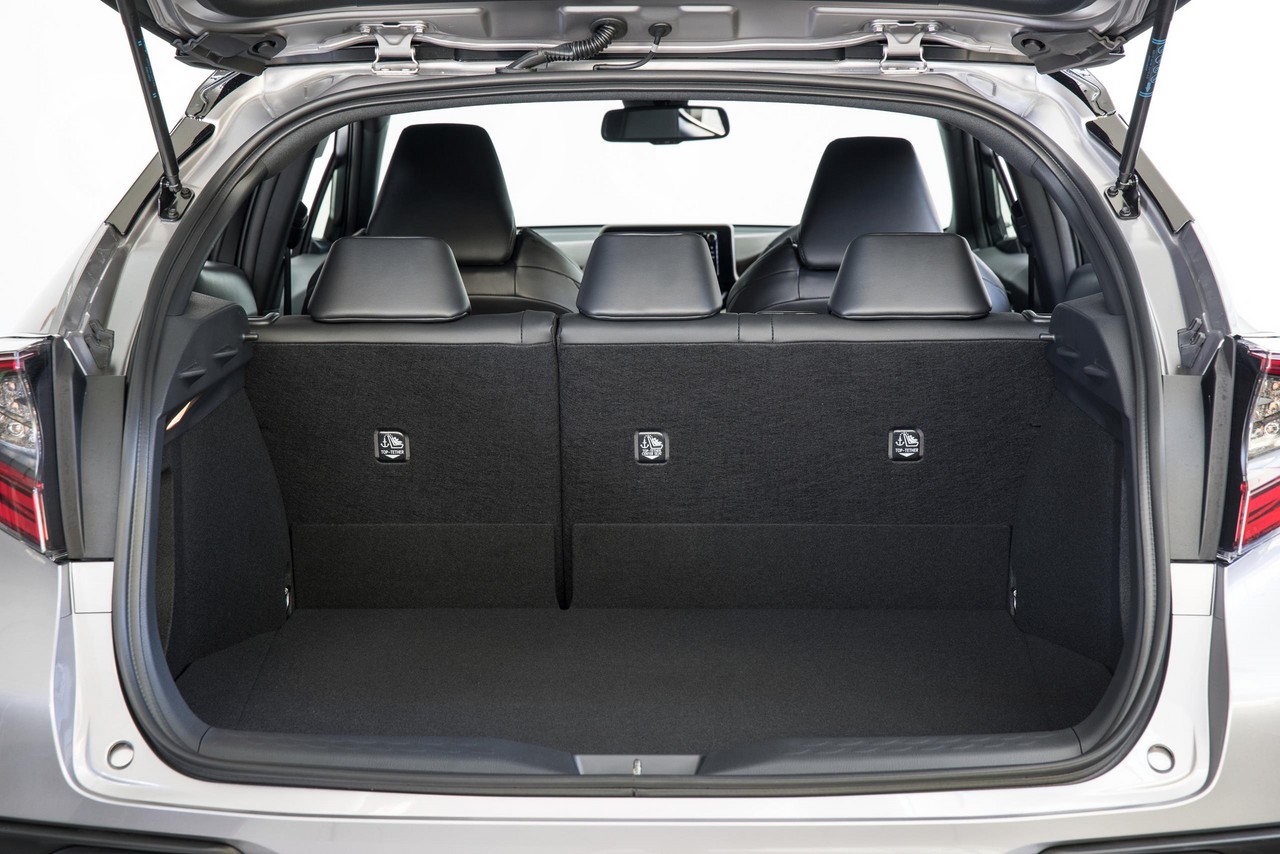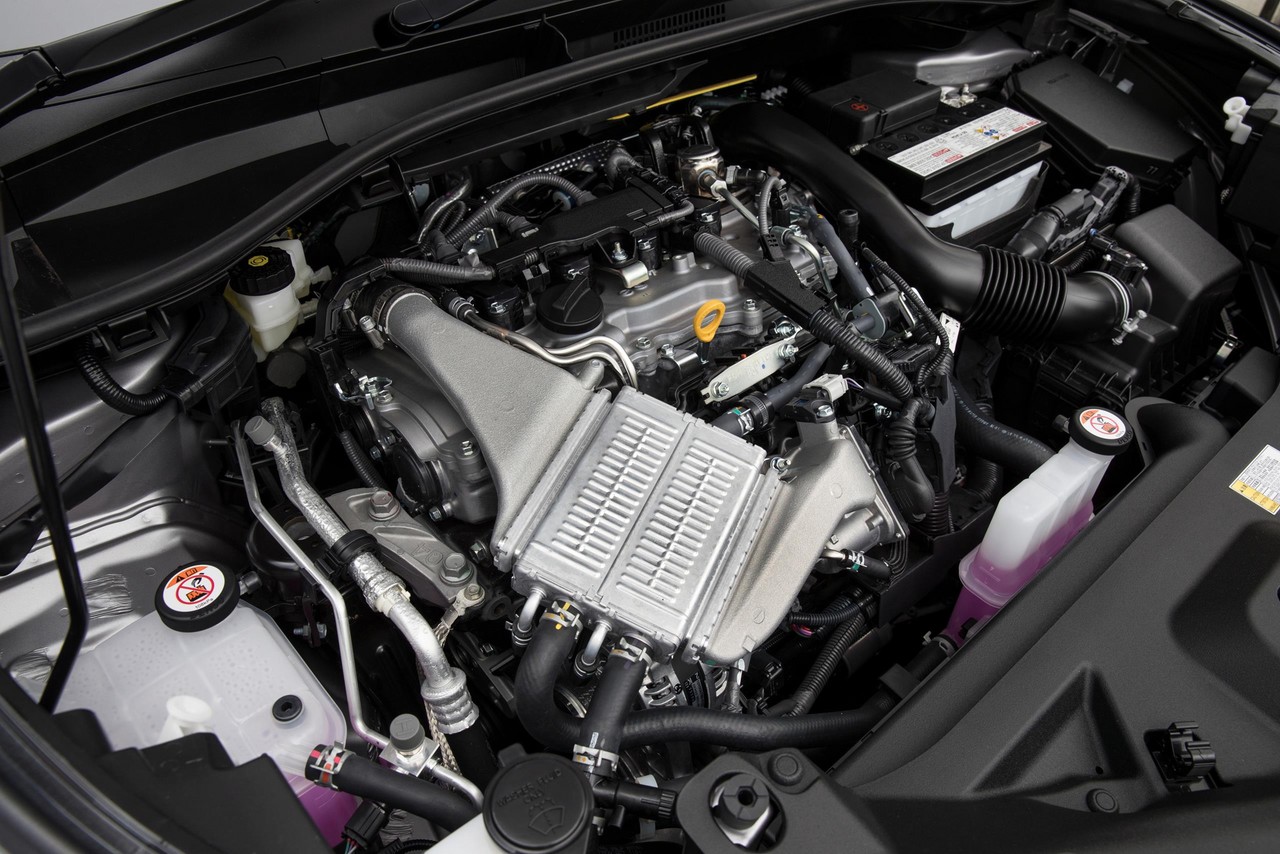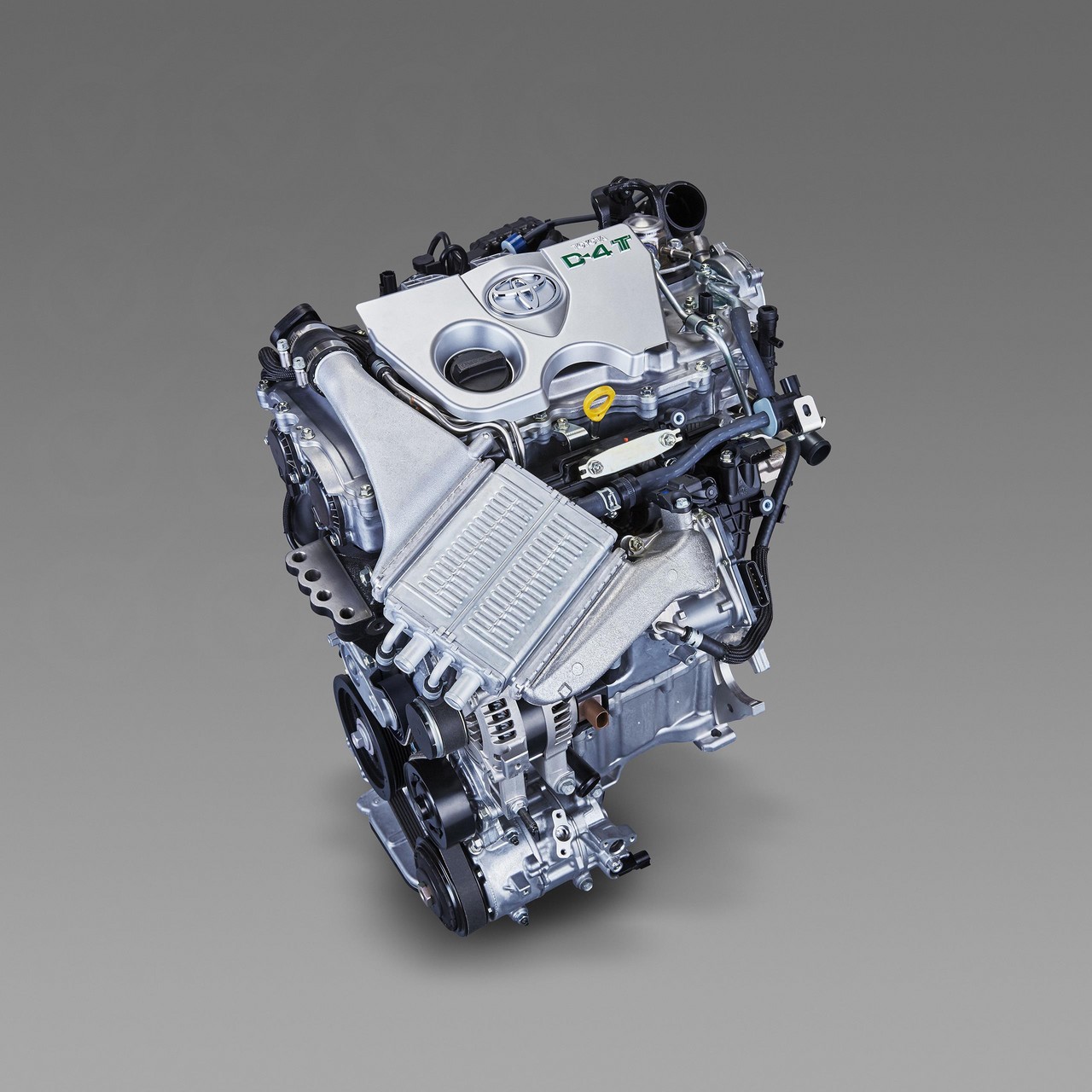
- Fuel-efficient 1.2-litre turbo petrol engine
- Impressive ride/handling balance
- Well-weighted steering
- Active safety technologies – including AEB – fitted as standard
- High standard of interior fit and finish
- Limited headroom (for front and rear occupants)
- Poor rear quarter visibility for driver
- Poor visibility and claustrophobic feel for rear seat occupants
Overview
Released in Australia in February 2017, the Toyota C-HR (‘Coupe High Rider’) was a five-door compact crossover vehicle. Manufactured in Iwate, Japan, the Toyota C-HR was powered by a 1.2-litre turbocharged petrol engine that was mated to either a six-speed manual or continuously variable transmission (CVT). While Toyota C-HR models with manual transmissions were front-wheel drive only, models with CVTs were available with all-wheel drive. For Australia, the Toyota C-HR range consisted of standard and Koba variants.
Powertrain: 8NR-FTS engine
The 1197 cc 8NR-FTS petrol engine had an aluminium alloy block and cylinder head (with integrated exhaust manifold), double overhead camshafts, a water-cooled single-scroll turbocharger, intercooler with an independent low-temperature cooling circuit, four valves per cylinder, direct injection (Toyota’s ‘D-4T’) and a compression ratio of 10.0:1.
While the exhaust valves for the 8NR-FTS engine had variable timing, the intake valves had a mid-position camshaft lock mechanism which could retard the variable valve timing, known as ‘Variable Valve Timing – Intelligent Wide’ (VVT-iW). The ability to retard intake valve timing enabled the 8AR-FTS engine to:
- Start in the Otto cycle;
- For low-rev operations to minimise fuel consumption, switch to an Atkinson cycle (i.e. the intake valves were kept open during the initial stage of the compression stroke as the piston was ascending and delayed closure of the intake valves until the end of the expansion stroke); and,
- Use an Otto cycle at higher engine speeds for greater power
For the Toyota C-HR, the ‘intelligent’ manual transmission had a rev matching function that – for more refined gearshifts – would increase engine revs when downshifting and reduce engine when upshifting. For the continuously variable transmission (CVT), the driver could engage an ‘M-mode’ which provided manual access to seven simulated gears.
Over the combined ADR 81/02 test cycle, fuel consumption for the front-wheel drive Toyota C-HR with manual transmission was 6.3 litres per 100 km.
| Engine | Trans. | Drive | Peak power | Peak torque | |
|---|---|---|---|---|---|
| Toyota C-HR | 1.2-litre 8NR-FTS turbo petrol I4 | 6sp man. | FWD | 85 kW at 5200-5600 rpm | 185 Nm at 1500-4000 rpm |
| CVT | FWD, AWD |
‘Dynamic Torque Control’ AWD system
The Toyota C-HR was available with Toyota’s ‘Dynamic Torque Control’ AWD system. In normal conditions, the engine’s torque was directly solely to the front wheels for maximum fuel economy. However, an electro-magnetic coupling could engage to direct 50 per cent of the engine’s torque to the rear wheels (i.e. a 50:50 front:rear torque split). Furthermore, the system included:
- Cornering Control: ‘a specific logic which allows the driver to track the intended driving line by adjusting the drive force depending on driving conditions’;
- Pre-torque Control: adjusted the front:rear torque distribution to 90:10 when the driver operated the steering wheel. According to Toyota, Pre-torque Control ‘ensures good response to changes in the steering angle when cornering’; and,
- Yaw-rate feedback control: corrected understeer and oversteer by adjusting front and rear drive force every six milliseconds.
Body
The Toyota C-HR was underpinned by the ‘Toyota New Global Architecture’ (TNGA) and shared its GA-C platform with the Toyota XW50 Prius . Compared to the Toyota E180 Corolla hatch , the Toyota C-HR was 85 mm longer (at 4360 mm), 35 mm wider (1795 mm), 105 mm taller (1565 mm) and had a 40 mm longer wheelbase (2640 mm). Luggage space for the Toyota C-HR was 377 litres.
The standard Toyota C-HR had a drag co-efficient of 0.34 Cd, while the C-HR Koba had a drag co-efficient of 0.35 Cd. Furthermore, the front-wheel drive Toyota C-HR with manual transmission had a kerb weight of 1375 kg.
Suspension and steering
The Toyota C-HR had MacPherson strut front suspension and double wishbone rear suspension. Furthermore, the C-HR had rack-and-pinion steering with electric power assistance; the steering wheel required 2.76 turns from lock to lock, while the minimum turning circle was 10.4 metres.
Safety equipment
Standard safety equipment for the Toyota C-HR included dual front airbags, a driver’s knee airbag, front seat-mounted side airbags, full-length curtain airbags (i.e. for front and rear occupants), ABS, electronic brake force distribution, brake assist, electronic stability control, traction control and front seatbelts with pre-tensioners and load limiters.
As standard, the Toyota C-HR was equipped with ‘Toyota Safety Sense’ which included:
- Pre-Collision System (PCS) with Autonomous Emergency Braking (AEB): operating at speeds above 10 km/h, PCS used a front-mounted monocular camera sensor and millimetre-wave radar sensor to detect vehicles and pedestrians on the road ahead. If there was a risk of a collision, the driver received an audible warning and an alert was shown in the multi-information display. In its second stage, Pre-Collision Brake Assist would prepare the braking system so that it would respond faster if the brake pedal was depressed. If the driver did not react and a collision was imminent, the brakes were applied automatically to reduce vehicle speed and the severity of a collision;
- Lane Departure Alert (LDA) with steering assist: used the windscreen-mounted camera to monitor the vehicle’s position relative to lane markings painted on the road surface. If the vehicle was about to depart from its lane without the turn indicator having been applied, a buzzer alerted the driver and a warning would illuminate on the multi-information display. If the vehicle continued to move outside the lane, light steering force was applied to return the vehicle to its lane;
- Sway Warning System (SWS): could detect if the vehicle was drifting in its lane which indicated that the driver may be fatigued. If detected, the driver would receive audible and visual warnings;
- Active Cruise Control (ACC): using the same millimetre-wave radar as PCS, ACC could maintain a safe distance from the vehicle ahead when cruise control was activated – this included applying the brakes to bring the vehicle to rest if necessary and accelerating back to the pre-selected cruising speed when safe to do so. For Toyota C-HR models with manual transmissions, however, ACC would disable itself if vehicle speed fell below 40 km/h; and,
- Automatic High Beam: used the windscreen-mounted camera to detect the headlights of oncoming vehicles or traffic ahead and, if detected, automatically switched the headlights to low beam to avoid dazzling other road users. When the road was clear, the system reverted to high beams to enhance visibility.
As standard, the Toyota C-HR was also fitted with:
- Blind Spot Monitor: used radar sensors mounted on the rear corners to detect vehicles in adjacent lanes as they moved into the driver’s blind spot. If detected, the driver would be alerted to their presence by the illumination of LED warning indicators in the door mirror on the side of the Toyota C-HR where there was another vehicle, and the LEDs would remain illuminated while there was another vehicle in the driver’s blind spot. If the driver operated the indicators to move into the lane where there was another vehicle in the driver’s blind spot, the LEDs would flash rapidly; and,
- Rear Cross Traffic Alert: using the same radar sensors as the Blind Spot Monitor, Rear Cross Traffic Alert could detect traffic approaching from either side of the Toyota C-HR as it reversed out of a parking space. Similarly, LEDs in the door mirror would illuminate to warn the driver.
Euro NCAP testing
In Euro NCAP testing , the 2017 Toyota C-HR received a five star safety rating which included a 95 per cent adult occupant protection rating and a 77 per cent child occupant protection rating. In the frontal offset test, protection of the driver’s head, thighs and feet were rated as good, though chest and lower leg protection were rated as adequate (i.e. a slight risk of serious injury). Maximum points, however, were awarded in the side impact and pole tests.
Brakes
The Toyota C-HR had 298.5 mm by 28 mm ventilated front brake discs and 281 mm by 12 mm solid rear discs.
Features: Toyota C-HR
Standard features for the Toyota C-HR included 17 x 6.5J alloy wheels with 215/60 R17 96H tyres, a six speaker audio system with a CD player, auxiliary (3.5 mm) and USB inputs, Bluetooth mobile phone connectivity with audio streaming, a 6.1-inch touch screen with satellite navigation (including SUNA live traffic updates), dual-zone climate control air conditioning, cloth front seats with six-way manual adjustment, halogen projector-type headlights, LED daytime running lights and fog lamps, front and rear parking sensors, a rear view camera, rain-sensing wipers, a 60/40 split-fold rear seat, remote central locking, power adjustable and heated door mirrors with folding function, power windows, tilt and telescopic steering wheel adjustment, an electric park brake, an auto-dimming rear view mirror, a 12 volt power outlet (centre console), trip computer and an immobiliser.
Features: Toyota C-HR Koba
Relative to the standard Toyota C-HR, the C-HR Koba was further equipped with 18 x 7.0J machine-finished alloy wheels with 225/50 R18 95V tyres, leather-accented seats, heated front seats, a power adjustable driver’s seat, bi-LED headlights with sequential turn indicators, proximity key (i.e. keyless entry), push-button start, rear privacy glass and illuminated vanity mirrors. As standard, the Toyota C-HR Koba was also fitted with ‘nanoe’ (pronounced nano-e) air purifying technology which could moisture cabin air and neutralise odours, bacteria and allergens.
Whereas the standard Toyota C-HR and black and grey interior finishes, the C-HR Koba had mocha brown inserts on the dashboard, doors and central armrest, and a silver ornamentation strip across the instrument panel. Externally, the Toyota C-HR Koba could be identified by its LED rear combination lamps, while two-tone paint finishes were available as an extra-cost option.
Related links
- Toyota Australia: Toyota C-HR Press Kit (February 2017)
- Toyota Australia: 2016 Toyota C-HR Press Kit (November 2016)
- Toyota Australia: Toyota Announces Turbo SUV For Australia
- Toyota Europe: Toyota C-HR – Toyota’s Fresh New Take on the Crossover
